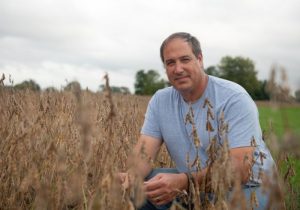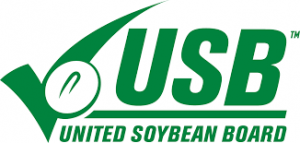Agronomy, Homepage Slider, New Uses, Soybean Quality
USB Adding Value to Your Soybean Checkoff
By Matt Reese and Dale Minyo
Farmer-leaders of the United Soybean Board (USB) announced a new strategic plan earlier this year that prioritizes sustainable soy solutions for global and domestic customers while ensuring value and profitability for U.S. soybean farmers.
The seating of the new Chair and Executive Committee at its December meeting included appointments of the Supply and Demand Action Team leads, Priority Area coordinators and Communication & Education Committee chair, among other key roles within the organization.
“We take checkoff dollars to create value for the U.S. soybean and we invest that in research, education and, of course, promotion,” said Steve Reinhard, United Soybean Board treasurer and board member who farms in Crawford County. “Every dollar invested is returning $12.34 back according to a Cornell study. We are trying to be very targeted and strategic in the investments we make.”

The USB Strategic Plan will guide checkoff investments in research, education and promotion across three priority areas of Infrastructure & Connectivity, Health & Nutrition, and Innovation & Technology. Each area is further divided into two additional areas of focus, supply and demand, and measured by resilience, differentiation and reputation.
Reinhard said the USB looks at opportunities to develop a wide range of uses for soy.
“Animal agriculture is still our No. 1 customer and we are talking more about biodiesel, bioheat, and even jet fuel, which will increase the crush of soybeans which means we will have a continued increase in meal. Meal has always been our driver in the past and we are getting to the point where oil is going to take that over,” he said. “We had a big discussion about more inclusion rates of meal in livestock diets and human health. It is our goal to make sure people know soy is a sustainable solution for every part of their lives. I even have a pair of Sketchers shoes with Goodyear technology in the soles using soy. It is the same technology that is in the tires you drive. You can have soy diesel in the tank and in the asphalt you drive on.”
To achieve results, the USB strategic plan includes market-focused strategies with clear plans of action. These overarching strategies include:
Strategy 1: Enable farmer-led pathways to tighten the U.S. soybean value chain, bridging innovations across supply and demand.
Strategy 2: Create and promote the unique identity, value and versatility of U.S. soybeans and soybean products through traditional and new opportunities.
Strategy 3: Position and empower farmers to capture value potential.
Strategy 4: Grow the soy checkoff as a primary industry resource and voice which is trusted, strategic and effective.
“The checkoff is committed to working on behalf of all U.S. soybean farmers, and the new strategic plan demonstrates that,” said Ralph Lott, USB Chair, from New York. “Launching our path into the future is powered by meaningful planning and goal setting. Our farmer-leaders did the work, and we now have a clear plan in place that shows us the best path forward. I look forward to providing sustainable soy solutions to every life, every day; it’s the reason why many of us farm and that’s to nourish our neighbors, community and the world.”
Approved with unanimous support from USB’s board of directors, the Strategic Plan Task Force served a critical role in creating the plan, engaging farmer-leaders and value chain partners and ensuring it reflected the future state of the industry. Task Force members represented USB, International Flavors & Fragrances, Cargill, Hanor Company, American Soybean Association’s World Initiative for Soy in Human Health and the Missouri Soybean Merchandising Council.
Checkoff investments continue to fund programs that build preference for U.S. soybeans across the country and around the world. Authorized by the Soybean Promotion, Research, and Consumer Information Act, the checkoff is composed of 78 members representing 29 states, in addition to the Eastern and Western regions. The number of seats on the board is determined based on bushels produced in their region. Members must be soybean farmers nominated by a Qualified State Soybean Board.
“This group of farmer-leaders represents a variety of operations and unique points of view across the many growing regions of our country,” said Meagan Kaiser, USB Vice Chair from Missouri. “We all share a common goal to maximize the profit opportunities for every U.S. soybean farmer, and I’m eager to work together to strengthen our collective future.”
For more on the USB Strategic Plan, visit: unitedsoybean.org/strategic-plan/.